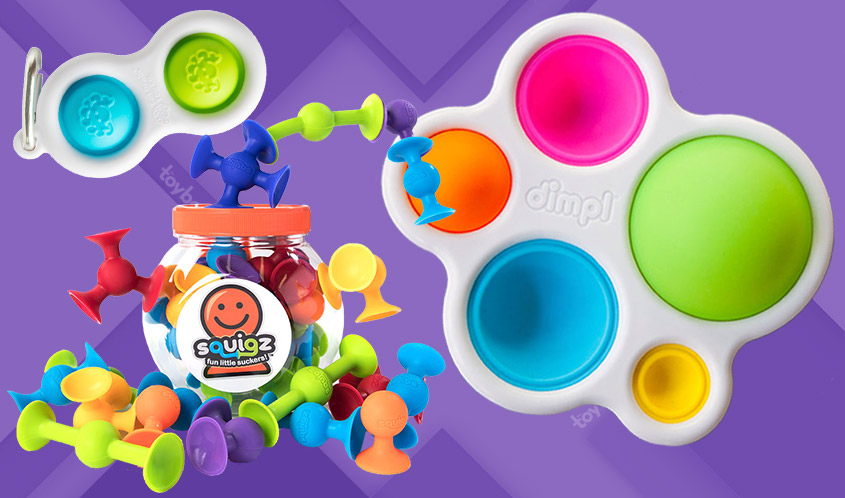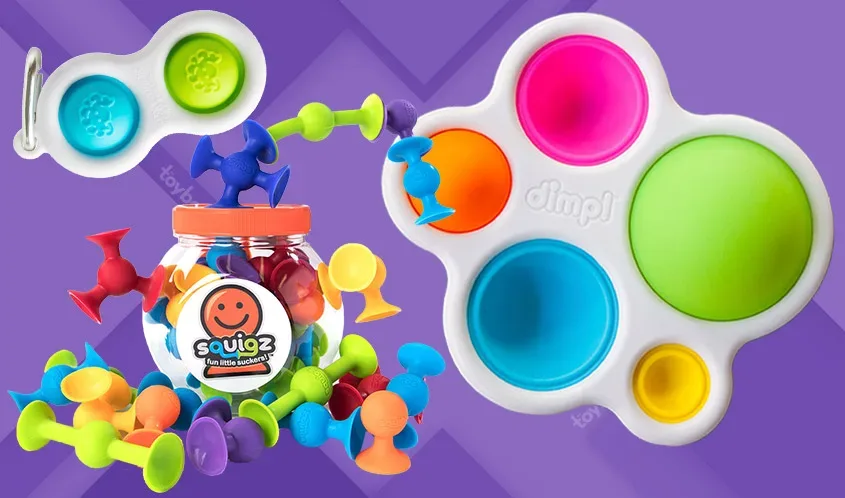
From babies looking for something to fiddle with to teens hoping to go viral on social media, the popularity of fidget toys is at an all-time high.
Fat Brain Toys has been at the forefront of this trend long before TikTok even existed with toys that encourage fine motor skills, spatial reasoning, sensory exploration, and experimentation. The company its core values and toys with integrity to make sure its products last for the long haul.
The Toy Book spoke with the company’s president and co-founder Mark Carson to discuss how Squigz and Dimpl go beyond any fleeting social media trend.
Toy Book: Fidget toys and sensory toys are everywhere right now, but Fat Brain Toys has been creating these types of products for years. What were some of the classic fidget/sensory toys from Fat Brain, and how do they still hold up today?
Mark Carson: So true! We were hyper-focused on the sensory toy experience all the way back to 2011 when we started incorporating our special “velvet soft” coatings to our toys. But the best example is our Squigz line, which we introduced in 2013. Composed of various-shaped suction cups and made from 100% silicone, Squigz are sensory to the touch, but even more so to the ear. Going on eight years on the market, Squigz is still one of our top-selling toys and trending in a big way in 2021.
TB: Why do you think there’s such a growing interest in fidget toys even though they’re not necessarily new?
MC: I think it was Abraham Lincoln who said: “The best way to predict the future is to create it.” While I won’t pretend to be able to predict the next big thing, we were developing sensory toys and fidgety-type products long before they became popular because we were confident in their inherent play benefits. It was really just a matter of time before the masses recognized the extra dimension that comes along with sensory play.
TB: What sets your products apart from all of the other fidget toys flooding the market?
MC: In a word, quality. That word is tossed around liberally, but the quality of our design, materials, and workmanship simply lead to a better, safer product. I think that’s always my concern when companies rush to jump on the bandwagon; they inevitably take shortcuts in one of those areas and it’s the consumer who pays the price.
TB: Fat Brain Toys is a family-operated business. What is it like to work with your family and how are those values reflected in your brand?
MC: It really is a blessing that I try hard not to take for granted. My wife Karen and I started the company 18 years ago at the suggestion of my then 10-year-old son, Adam. Not only is Adam now our lead toy designer, but he’s also brought another toy tester into the world: our granddaughter, Emery! I think the core value that emanates from our family-based operation is authenticity. Our toy design decisions are being made quite literally in the living room, not the board room. We think that leads to a product that is properly focused on the needs of the child rather than the bottom line.
TB: What inspired your son to invent Dimpl?
MC: It was a classic example of several influences coming together in a really magical way. As part of his college education to be a physical therapist, he began working in a research lab to design 3D-printed, prosthetic hands for kids with Amniotic Band Syndrome. As part of that training, he also interacted with those kids to perform various tests of their fine and gross motor skills. Those tests often involved interaction with various toys and Adam took special note of how those toys were being used as “tools” for these kids. It wasn’t long after joining the company that he began experimenting with toys that were, at their core, reinforcing fundamental physical skills. Dimpl may have plenty of appeal as a fidget, but it was designed with a much higher purpose in mind.
TB: Do you think social media plays a big role in driving the popularity of fidget toys and does that play into how you design or market your products?
MC: I think it’s safe to say that social media plays a big role in the popularity of everything these days! I think it’s shortsighted to design products only for their social media appeal, but we do recognize the extra value when we discover a product that has highly demonstrable qualities, which certainly appeal to the TikTok generation.
TB: Fat Brain Toys started out as an e-commerce shop and then later opened up some retail stores. With more people shopping online due to the COVID-19 pandemic, did that push you to add any major updates to the website over the past year?
MC: Even though we have the most robust online toy store in the industry, I would still consider our website as eternally under construction because of how fast technology is changing. We did add several new features last year, but with the increase in online shopping, we spent significantly more development efforts on optimizing our operations to scale to the increased traffic and awareness of the Fat Brain brand.
TB: What are some of your goals or new products planned for this year?
MC: We have so many exciting products launching this year! Dimpl has become a brand unto itself and will be branching into several new product categories. There are a lot of “me too” products rushing to the market, but we see the Dimpl innovation continuing long after the current fidget craze has faded.

